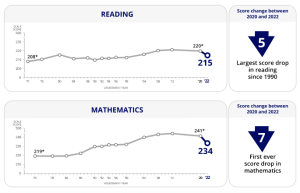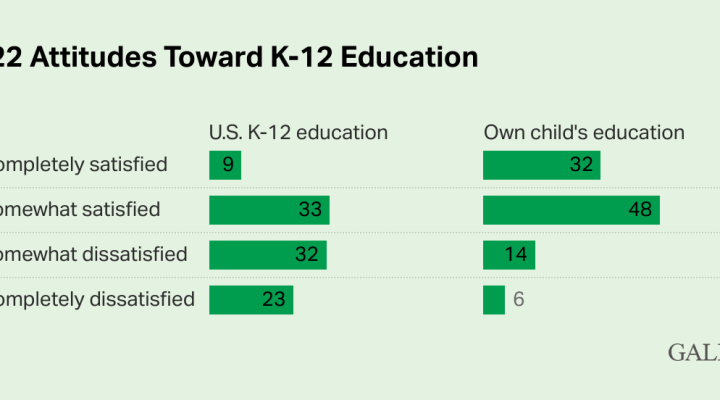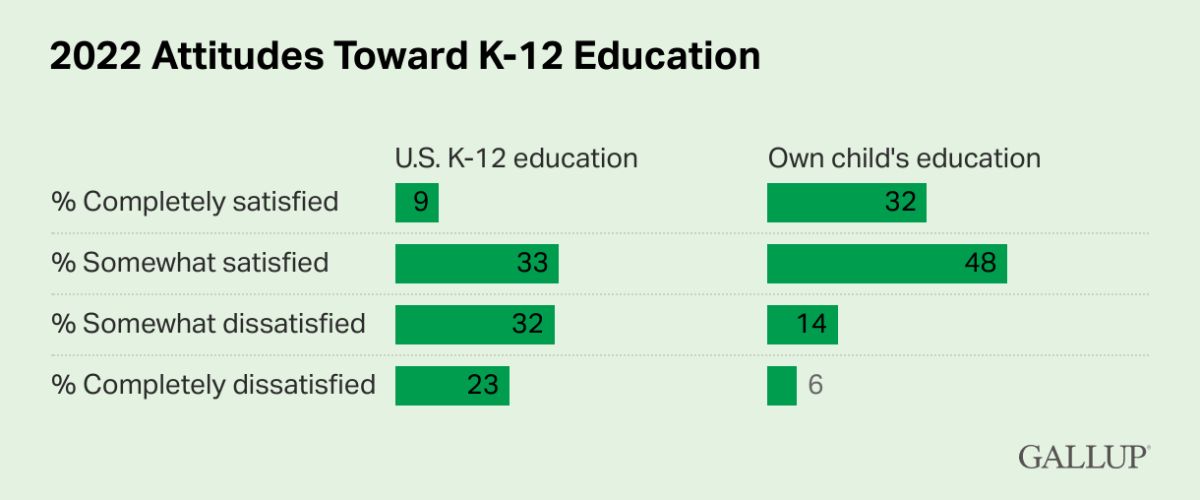American parents remain as satisfied as ever with the quality of their children’s education despite the hardships of COVID-related school closings, virtual learning and a national campaign to discredit public education, recent research shows.
Even a federal study documenting drops in mathematics and reading scores among some elementary school students since 2020 has not dampened the support many parents express for local public schools, Gallup Senior Scientist Frank Newport said in a recent analysis of the polling data.
“In short, despite all the disruptions of the past two years, there is no sign of a pandemic-era drop-off in parents’ positive views of their children’s schooling,” Newport said.
“According to ongoing Gallup tracking, the views of parents of schoolchildren about the quality of education their children are receiving do not appear to indicate that the pandemic caused major harm. Parents remain solidly positive about their kid’s quality of education — as they have been for over 20 years.”
 But the National Assessment of Educational Progress, which is a project of the U.S. Department of Education, has found that the pandemic had measurably negative effects on student learning.
But the National Assessment of Educational Progress, which is a project of the U.S. Department of Education, has found that the pandemic had measurably negative effects on student learning.
NAEP administered a test this year to measure the effects of the COVID-19 pandemic on the reading and math skills of 9-year-old students across the country. Overall, scores dropped 7 points in mathematics and 5 points in reading from 2020 to 2022.
“This is the largest average score decline in reading since 1990, and the first ever score decline in mathematics,” according to NAEP.
That kind of news appears to resonate more with the American public at large than with parents. A September Gallup survey found that most Americans — whether they have kids in school or not — hold a dim view of K-12 education as a whole.
“The 42% who say they are satisfied today is the lowest measured in the past two decades by one percentage point and the second-lowest reading in Gallup’s 23-year trend,” the Gallup report said. “Americans’ satisfaction with schools was at a near-record high of 51% in 2019 before dropping slightly each year since.”
 But the same poll revealed that American parents expressed much more positive views of the education their children are receiving in grades K-12, Gallup said. “The 80% who are completely or somewhat satisfied is slightly improved from the 73% measured a year ago and exceeds the average of 76% that Gallup has recorded since 2001.”
But the same poll revealed that American parents expressed much more positive views of the education their children are receiving in grades K-12, Gallup said. “The 80% who are completely or somewhat satisfied is slightly improved from the 73% measured a year ago and exceeds the average of 76% that Gallup has recorded since 2001.”
So, why do parents seem to be so relatively unfazed by the effect the pandemic has had on their children’s education? Newport offered several theories in his analysis of the polling data.
“It is possible that parents are not yet cognizant of the pandemic’s effect on their children’s quality of education. The only NAEP scores released to date are for 9-year-olds, and those came out after the Gallup update was conducted. Until now, parents may have had no quantifiable basis for assessing what their kids did or did not learn during the pandemic. As more evidence becomes available, parents’ perceptions could change.”
Or, it could be that the disconnect between parents’ opinions and those of average Americans may have something to do with the intricacies of polling. For decades, researchers have noticed a “local-national gap” in which survey respondents tend to be more optimistic about issues like crime and health care on a local level, and more pessimistic when considering the condition of these and other topics nationally, he said.
“It is thus no surprise that parents would be more positive about their child’s education than they are when asked about the distant and amorphous quality of education nationwide.”
Another possibility is that parents may be reluctant to think negatively about education despite any setbacks caused by the coronavirus outbreak, Newport said. “Along these lines, parents’ continuing satisfaction with the quality of their child’s education could reflect an endorsement of the efforts their child’s school put forth in dealing with the pandemic — even if learning suffered during that period.”
Politics may be another factor as partisanship is known to heavily influence Americans’ attitudes about education at the national level, Newport added.
“There is a major difference in the views of U.S. education in general between Democrats and Republicans, with Democrats on the more satisfied end. There are also major partisan differences when it comes to confidence in public schools.”
Those divisions diminish when parents are asked about their children’s schools and educations.
But those divisions diminish when parents are asked about their children’s schools and educations. Newport noted that surveys conducted in 2021 and 2022, in fact, reveal that partisan differences among parents are “minimal” on the issue.
“Republican parents are slightly less satisfied than Democratic parents with the quality of education their child receives. But this difference is significantly smaller than the partisan gap seen when these parents are asked about the quality of education in the U.S. more broadly. And importantly, a substantial majority of both Republican and Democratic parents are satisfied with the quality of education their child receives.”
Newport said the trend may reflect an approval of the way local politics influenced schools’ handling of the pandemic — with some staying open while others adopted virtual learning approaches.
 “What the local districts did in handling the pandemic thus had a good probability of meeting the approval of local parents. Parents living in more conservative areas in which schools were kept open may be positive about their child’s quality of education as a defense of the way their schools handled the crisis. Parents living in more liberal areas in which schools were closed may themselves be more positive about their child’s quality of education as a defense of the way their schools handled the crisis.”
“What the local districts did in handling the pandemic thus had a good probability of meeting the approval of local parents. Parents living in more conservative areas in which schools were kept open may be positive about their child’s quality of education as a defense of the way their schools handled the crisis. Parents living in more liberal areas in which schools were closed may themselves be more positive about their child’s quality of education as a defense of the way their schools handled the crisis.”
And it may just be that many parents give more weight to their children’s overall education than they do to the effects of the pandemic, he said. Even those who expressed dissatisfaction with the quality of education most often did not cite the pandemic as a reason.
“Only 2% of all respondents mentioned the negative impact of COVID or school closures as the reason for their dissatisfaction with education in the U.S. Americans instead listed a wide variety of factors that are independent of the pandemic and that predate the pandemic — problems with school curriculum and educational approach, the lack of resources for schools, the political agenda being taught in schools, and school climate.”
Related articles:
It’s time to stop the insanity that is killing public education | Opinion by Mark Wingfield
Public education declined in U.S. eyes, new survey shows
Who’s behind the nationwide attacks on local school boards over Critical Race Theory?


